Back in May 2009 some 60 Nobel Prize winners, some of the best minds on the planet, meeting as the St James’s Palace Nobel Laureate Symposium issued a memorandum under the call of The Fierce Urgency of Now:
- calling on world leaders for a global deal on climate change that matches the scale and urgency of the human, ecological and economic crises facing the world today. [ie, May 2009]
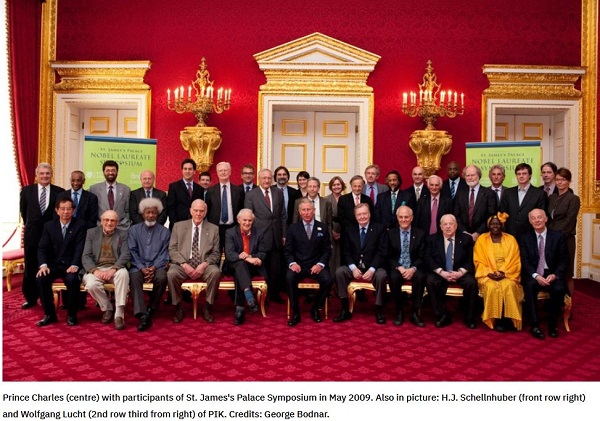
The conference site is no longer there; you can read about it courtesy of The Potsdam Institute for Climate Impact Research at 60 Nobel Laureates: Copenhagen must be a Turning Point towards Global Sustainability. The St James Palace Memorandum is available on the Cambridge Network courtesy University of Cambridge Office of Communications.
I posted about the conference in 2009, and reprised the post in 2011 in Climate crunch: the fierce urgency of now. In it I reminded readers that in 2003 James Hansen said that we had about 10 years to get ourselves organised to tackle global warming and climate change. In December 2007 Hansen had advised 25,000 scientists at the American Geophysical Union Conference that for a safe climate we should turn down the planetary heating dial by reducing CO₂e levels in the atmosphere to 350ppm. At the time CO₂ alone was 387ppm.
The clarion call from St James Palace was roundly ignored at the December 2009 UNFCCC Conference of Parties at Copenhagen, which crashed and burned, rat-f***ed by the Chinese according to Kevin Rudd. In truth Copenhagen was not their work alone, but a disaster it surely was.
In my 2011 post I favoured a stabilisation scenario outlined by Bill Hare to keep warming below 1°C, but modified it to reach net zero by 2030. We had options back then. I warned, however, that it would probably take the about 10 years for the world to wake up and by then it would be desperately close to game over as far as our emissions budget was concerned.
So how have we been going?
In April this year the New Scientist published a review of our performance in Climate change in graphics: The charts that show we must act now (pay-walled). Here’s a selection:
First, CO₂ from 1750 on:
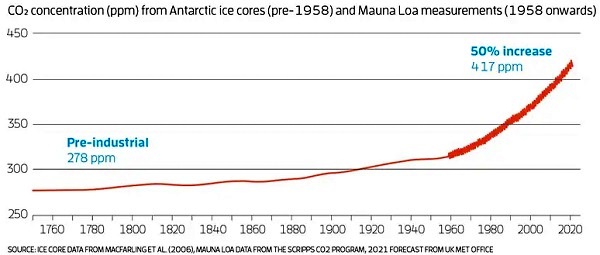
You will often hear it said that COVID helped up to reduce emissions in 2020. Very simply, there is no COVID effect visible on the Mauna Loa record.
Then try methane:
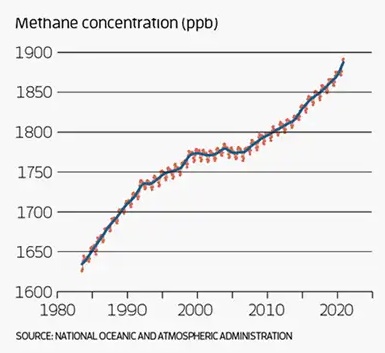
and nitrous oxide:
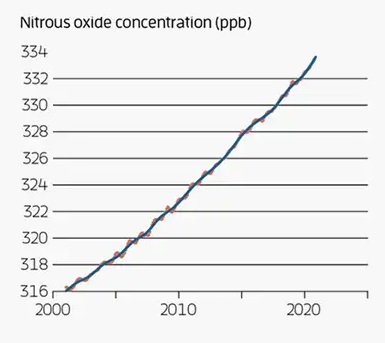
Scientists are puzzled about the methane. From the New Scientist again, analysis of isotopes is leaning towards or a biogenic source for the surge, meaning microbes in wetlands, rice paddies, livestock, permafrost and landfill sites, with the real focus on tropical wetlands. This combines with a new realisation that methane is hugely potent over short periods.
ABC did a fact check on Adam Bandt’s claim that gas is just as dirty as coal in generating electricity. There are uncertainties. We don’t measure fugitive emissions. Gas is definitely more energy intensive than coal.
The biggest difference, however, lies in the time frame adopted. Methane turns into CO₂ and water over a 12-year period. If you spread the warming affect over a hundred years, as Angus Taylor and Australia officially do, then methane is 28 times more potent than CO₂. If your time-frame is 20 years like Adam Bandt’s, then methane is a whopping 86 times more potent.
The lingo calls it 100 or 20-year GWP (global warming potential).
Fact Check estimated that:
- open-cycle (peaking) gas turbines produce 28 per cent less emissions per kilowatt hour of electricity than conventional (subcritical) black coal plants, 20 per cent less than high-efficiency (supercritical) black coal plants, and 45 per cent less than brown coal plants.
Combined-cycle gas turbines are less flexible than open-cycle plants, but they tend to be efficient and are more comparable to baseload-producing coal plants.
They produce a volume weighted average of 46 per cent less emissions per kilowatt hour than subcritical coal plants, 40 per cent less than supercritical coal plants and 58 per cent less than brown coal-fired plants.
As far as I can see those estimates were made on a 100-year GWP, whereas the world is now focussed on 30 years, which surely makes gas three times more potent than they say. Until shown otherwise my working conclusion is that gas is as bad as or worse than coal. Clearly its use should be minimised.
Now sea level rise (SLR):
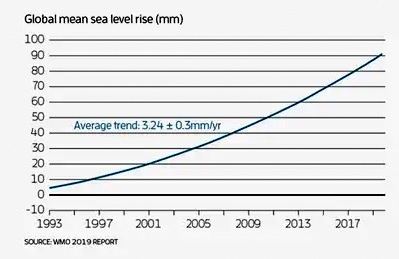
That graph gives an excellent image of the way SLR is trending. In my post Five climate graphs that matter: 2020 I cited information from Prof John Englander which showed SLR had averaged 2mm/year for the 20th century. In the decade 2009-2019 it averaged 4.5mm+.
From the first official UN concern about climate change in the early 1990s the talk was to avoid DAI, that is ‘Dangerous Anthropogenic Interference’ in the climate. That changed to the ‘2°C guardrail’ for a ‘safe’ climate when Two degrees was accepted as an official limit by the UNFCCC Conference of Parties in Cancun in 2010, then embodied into the Paris Agreement in 2015, along with the desirable aim of limiting warming to 1.5°C in recognition of concerns of the low-lying island states who feared inundation.
Someone should have told them that when we reached the milestone on 400 ppm of CO2 on May 9, 2013, NASA advised welcome to the Pliocene:
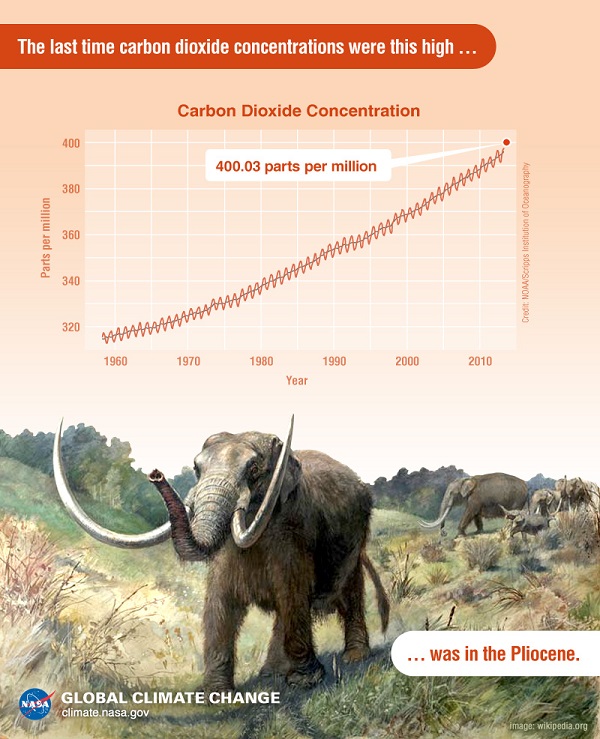
- Imagine there are no people. Imagine a planet where the sea level is about five to 40 meters (16 to 131 feet) higher than normal. Imagine a planet that is hotter and wetter. Imagine, worldwide, it’s roughly 3 to 4 degrees Celsius (5.4 to 7.2 degrees Fahrenheit) warmer than today. And the North and South poles are even warmer still – as much as 10 degrees Celsius (18 degrees Fahrenheit) hotter than today.
Welcome to the Pliocene. That was the Earth about three to five million years ago, very different to the Earth we inhabit now. But in at least one respect it was rather similar. This is the last time that carbon dioxide (CO₂) levels were as high as they are today.
See also my Scoping long-term sea level rise, much of which was information I collated in a series of posts in 2008. Our current level of greenhouse gases commits us to civilisation-threatening multi-metre sea level rise, if paleoclimate science is our guide. The main question is how fast it will happen.
Andrew Glikson in his new book The Event Horizon: Homo Prometheus and the Climate Catastrophe says that while there is no complete analogue for what we are doing, we are forcing the climate 30 times harder than the orbital changes which brought us out of the last ice age into the Holocene, and what happened 55 millon years ago in the Paleocene-Eocene Thermal Maximum (PETM) when the temperature jagged up 5–8°C over 20,000 to 50,000 years. For an equivalence we need to go back to the asteroid strike of 65 million years ago which did in the dinosaurs and made space for the rise of the mammals. This is how he represents the impacts graphically:
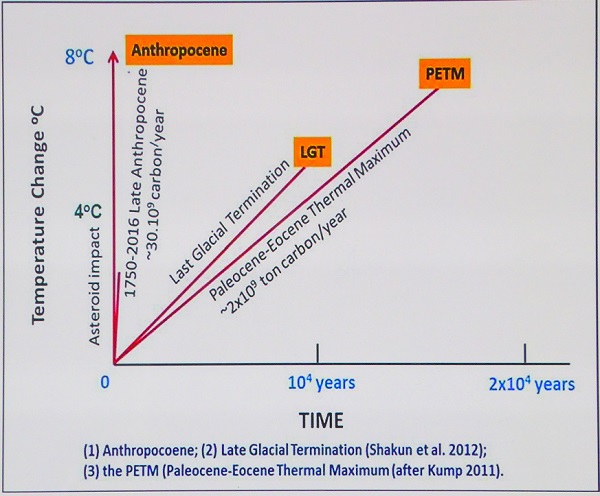
Really there is no excuse. We knew in the early 1990s that during the Eemian interglacial about 120,000 years ago sea levels were 3-5 metres higher than now with 300 ppm of CO₂. Later estimates made that 6-9 metres.
The IPCC has always regarded paleoclimate science as not scientific enough to take into consideration in assessing future climate risk, and has tended to limit the risk horizon to the end of this century. Look at how they treated the Antarctic in high emissions scenarios in IPCC AR5 published in 2013:
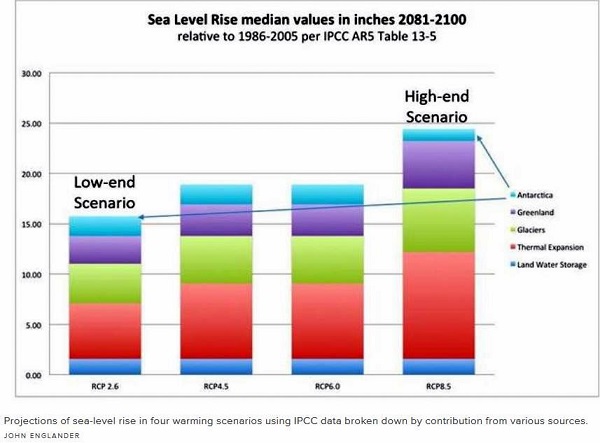
David Spratt has been on their case since 2007, when the IPCC spectacularly got Arctic sea ice melting so wrong:
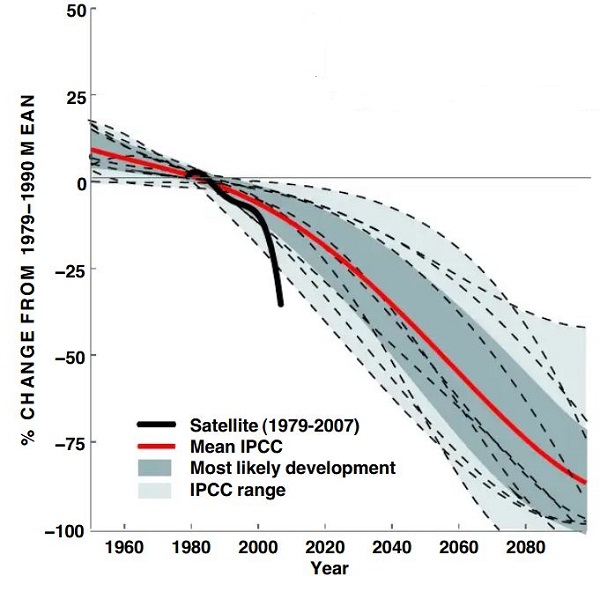
Since then he’s been advocating GHG drawdowns to about 320ppm and a return to warming of about 0.5°C for a safe climate and a liveable planet. There was never any budget of burnable carbon. Spratt called it in May 2014 in The real budgetary emergency and the myth of “burnable carbon”.
Spratt let fly again recently with a post of March this year Zero by 2050 or 2030? 1.5°C or 2°C? Overshoot or not? Demystifying carbon budgets. He was summarising the findings of a Breakthrough Briefing Note on “Carbon budgets for 1.5 & 2°C”. The main findings were:
- IPCC carbon budgets underestimate current and future warming, omit important climate system feedback mechanisms, and make dangerous assumptions about risk-management.
- 1.5°C of warming is likely by 2030 or earlier, a product of past emissions.
- There is no burnable carbon budget for the 1.5°C goal; such “budgets” rely on overshoot, with unrealistic reliance on speculative technologies.
- The current level of greenhouse gases is enough for around 2°C of warming, or more.
- 2°C of warming is far from safe, and may trigger the “Hothouse Earth” scenario.
- There is no carbon budget for 2°C if a sensible risk-management approach is taken.
- Even accepting the IPCC carbon budget for 2°C at face value, emissions need to be zero before 2030 for developed countries with higher per capita emissions.
(Emphasis added)
‘Breakthrough’ is the name given to the National Centre for Climate Restoration, The paper was prepared by Spratt, Breakthrough’s research director, and Ian Dunlop, former coal industry executive and chairman of the Australian Coal Association.
Spratt and Dunlop reference every statement they make with scientific literature, which has been somehow neglected, perhaps because it doesn’t fit the dominant narrative.
Anyone not living under a rock knows that the IEA (International Energy Association) produced a report last week Net Zero by 2050: A Roadmap for the Global Energy Sector. Read the press release Pathway to critical and formidable goal of net-zero emissions by 2050 is narrow but brings huge benefits, according to IEA special report and/or the full 224 page report.
The Roadmap sets out more than 400 milestones to guide the global journey to net zero by 2050. These include, controversially:
- from today, no investment in new fossil fuel supply projects, and no further final investment decisions for new unabated coal plants.
(Emphasis added)
Volker Roeben at The Conversation tells that the IEA was established in the wake of the 1973 oil crisis to advise governments how to maintain the stability of the international oil supply. So it was a surprise when world’s leading energy adviser, founded to protect oil supplies, now wants to ban new fossil fuels.
I did hear that the IEA report was commissioned by the UK Government in prepartion for the Glasgow UNFCCC Conference of Parties this year. Neither the Foreword nor the Acknowledgements by Executive Director Dr Fatih Birol say that. However, it is clear that he is fully behind the 2050 net zero program and more than willing to exercise leadership. The involvement of industry in the report is impressive.
Fossil fuels are not going to disappear, according to the IEA:
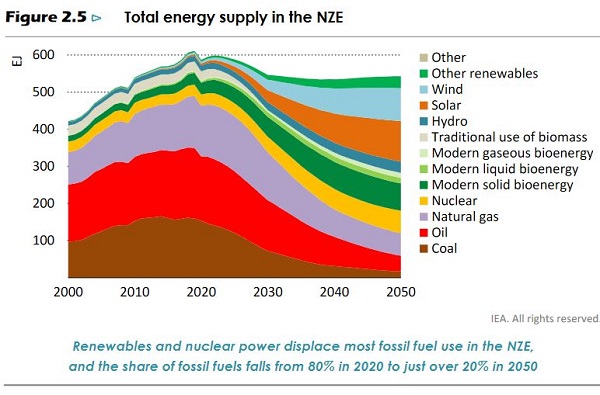
Here’s fossil fuel production:
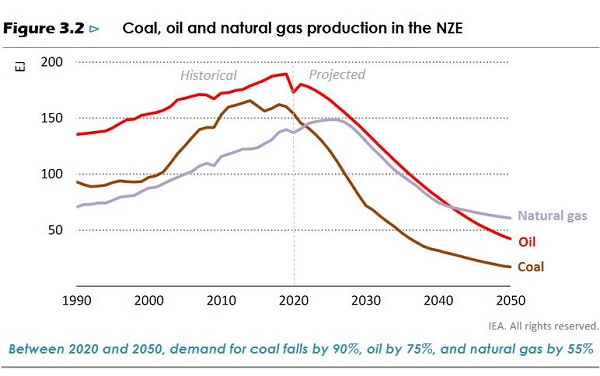
Here’s how they see electricity generation by source:
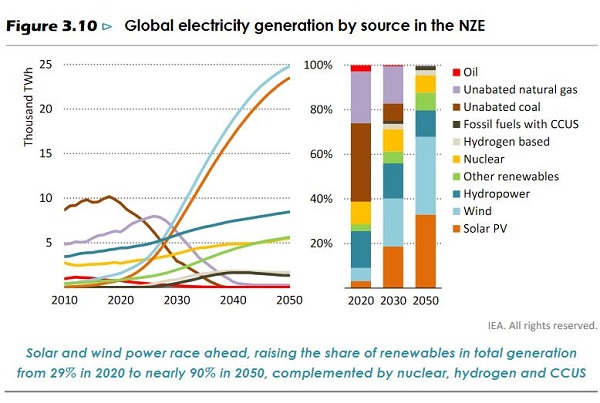
Here’s net emissions by sector:
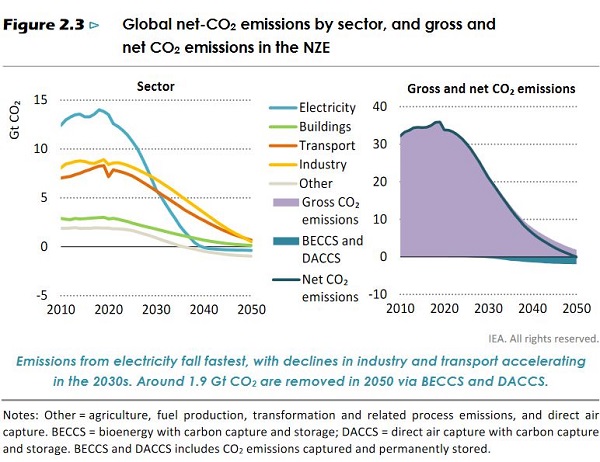
You may have noticed that their toolkit includes carbon capture and usage as well as direct air capture. These tend to be rubbished in some sectors, but Ralph Garnaut sees them as technically established tools which need to be scaled and deployed.
Meanwhile pretty much simultaneously our government headed in the opposite direction by announcing a new taxpayer funded $600 million gas-fired peaker at Kurri Kurri, to be used 2% of the time, as Laura Tingle says, solving a problem that didn’t exist, except perhaps politically.
John Hewson does an excellent roundup of where the Morrison government is at in Reckless Morrison Government Must Move On Climate Change. To me Morrison avoids accountability like the plague, so we will never expect pinned down targets from him. If it works, he’ll take credit, if not it’s someone else’s fault.
I gave my opinion of his policy in Cheap accounting tricks and sovereign risk: the Morrison government’s climate policy. My view has not changed, except I see an increase of deceptive blather. New research from the Australia Institute research shows our emissions increasing if you set aside land use:
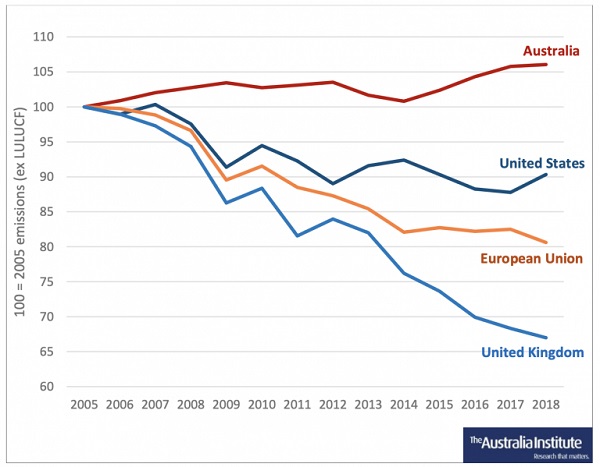
The G7 agrees to stop financing coal projects by the end of 2021, but there has been pushback from Asia. The New Scientist article linked above shows emissions by region:
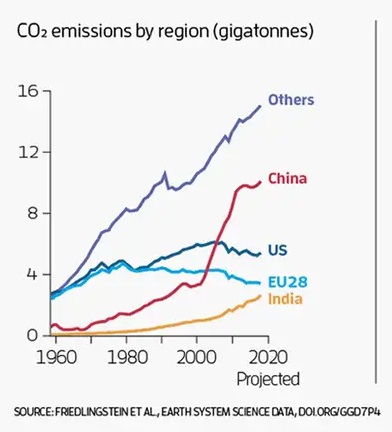
The US, the EU, India and China clearly matter, but so does ‘Other’. Every bit of ‘Other’ matters, including us.
China will do what it wants to do, as will India, who say their emissions are 60% below the world average and it is the duty of those who made the mess to clean it up. However, that attitude is based on the false notion of the existence of a budget of burnable carbon. Also it would be helpful if the Chinese desisted from building fossil plants in the ‘Other’ category.
Elsewhere, the WEF (World Economic Forum) has a piece on Climate change: What is ‘net zero’ and why does it matter? It’s good that they are signed up to the project, but they also said this:
- It [‘net zero’] may be the latest buzzword in the world of climate action but it’s key to keeping us safe from harm, scientists say.
Sorry, scientists do not say that net zero will keep us safe from harm. They say that if we achieve net zero by 2050 and then draw down GHGs to achieve negative emissions thereafter, we will have around a 50/50 chance of limiting warming to 1.5°C. They also say the dragons probably lie beyond 1.5°C. The dragons are tipping points where the effect takes on a life of its own, causing further change outside human control. Many of them are afraid for humanity, but are not able to say so in public.
Many are afraid that dragons are already loose in our midst.
For example, when Jo Chandler was researching her book Feeling the heat (published 2011) she asked Ove Huegh-Guldberg, over a bottle of wine at sunset on the beach at Heron Island, the big question “Are we f****d?” He answered, in terms of coral reefs, probably. However, his work is intrinsically interesting, he is by nature hopeful, and his work may make the outcomes better.
Beyond that he was also worried that what was happening will “affect the very capacity of the planet to support people.” Yet scientifically, he couldn’t say that in a way that was scientifically defensible. His science simply does not stretch that far.
James Hansen did do the big science, for example in Assessing “Dangerous Climate Change”: Required Reduction of Carbon Emissions to Protect Young People, Future Generations and Nature (2013), also available at NASA. Hansen lined up 17 co-authors, including Huegh-Guldberg and Johan Rockström, who currently heads the Potsdam Institute for Climate Impact Research, which gives them cover, and allows them to support what they may not say on their own.
The IPCC seem not to take Hansen seriously, presumably because he takes paleoclimate science seriously.
I was a bit excited last week to come upon an article about Harald Desing and Rolf Widmer, two Swiss scientists who take exception to the odds given us by the IPCC and cite the above article by Hansen et al in doing so. The Swiss article is in pre-print form as Reducing climate risks with fast and complete energy transitions: applying the precautionary principle to the Paris agreement.
They believe that the odds offered in the IPCC scenarios:
- which limit peak heating to 2°C with 66% or, in more ambitious scenarios, to 1.5°C with 50% confidence, respectively. This results in very high – and considering that our life support system is at stake, also unacceptable – risks to the biosphere and humanity.
They assert that the IPCC accepts risks which endanger future generations without their permission. They find that the current climate debate consents to “residual” probabilities between 40% and >80%. I think that means a 40% to more than 80% chance of going pear-shaped. The upper bound clearly matters rather than the average when the stakes are the livability of the planet.
They note that many scientists argue that emissions should be reduced to 350 ppm, citing the above paper by Hansen et al, plus the paper Johan Rockström, Will Steffen et al Planetary Boundaries: Exploring the Safe Operating Space for Humanity (2009) and Will Steffen et al Planetary boundaries: Guiding human development on a changing planet.
Their answer is to go full tilt in moving to renewable technologies, even if it means a temporary boost in the use of fossil fuels.
Decarbonisation could be achieved by 2030, they say, but alas the chances of overshooting 1.5°C cannot be reduced below 20%. It is simply too late.
The bottom line, though, is that Desing and Widmer are offering hope. The new energy economy will be far more energy potent than the present one:
- If the Swiss team’s data is correct—and they have expressed 99 percent confidence in their calculations—a solar transition by 2030 could not only avert the worst risks of dangerous climate change by switching off the age of fossil fuels forever, it would usher a new age of clean energy abundance unleashing “unprecedented possibilities” for human civilization.
By the way, the 2013 Hansen paper called for a 6% reduction in emissions each year, starting immediately, that is, in 2013. They warn:
- If emissions continue to grow until 2020, as seems likely, emissions will need to reduce by 20% pa thereafter.
In addition, we will need to remove 100 GtC from the atmosphere and hold other greenhouse gases to net zero.
That’s carbon, not CO₂. For CO₂ multiply by 3.67.
100 GtC is roughly 10 years of fossil fuel emissions.
Where to now?
In September 2019 I attended a national conference of LEAN (Labor Environment Action Network) held in Sydney’s Ku-ring-gai Chase National Park. There I argued that it was impossible to offer young people hope by accepting 1.5°C when it meant more droughts, floods, wild and extreme weather, the loss of 70 to 90% of the world’s coral reefs, the possibility of multi-metre sea level rise within the century, and the certainty of such within the next two or three hundred years, plus a major species extinction event already under way. The only sensible path was to pursue drawdown beyond zero emissions to achieve 350 ppm or lower.
At that time I had written but not yet posted a long-read post (Climate emergency – ecological sustainability within planetary boundaries, and a safe climate – over 8000 words) on how we got into this mess and where we might go from here. If you scroll down to the heading Where to now? I would not change much.
Then Australia burned for about four months. It was clear that dangerous climate change was here. What we are facing now is not just a climate crisis, but in sober rational terms a fair chance of a climate calamity unless maximum action is taken now.
However, we have to act here in Australia, given the situation we are in.
At the Adelaide Writers Week in March, author Linda Jaivin interviewed Rebecca Huntley and Dr Jonica Newby who have just written books titled How to Talk About Climate Change in a Way That Makes a Difference and Beyond Climate Grief: A journey of love, snow, fire and an enchanted beer can. The session has now been broadcast by ABC RN as Changing minds on climate change.
They say about 9% of Australians are climate change deniers. Nothing will change their minds, so they must be ignored or defeated if they are in power. Clearly, the Morrison government is trying to play to the climate deniers as well as to those who have some concern but do not think climate change is serious.
Newby and Huntley say that people will act if something will affect them personally in the near term and tend to think in the short term. Fear is not a good motivator, which is unfortunate, because we should be afraid. Greta Thunberg wants adults, especially our leaders, to be afraid.
For many the fires made climate an existential threat and a high priority. Similarly sea level rise is increasingly impinging on people’s consciousness. Vast lengths of China’s coast are under direct threat (see Rising Seas Threaten China’s Long, Low, and Crowded Coast. Indeed Asia Is Home to 99 of World’s 100 Most Environmentally Vulnerable Cities. The Thwaites Glacier in Antarctic is being investigated by an international team, (see Antarctica melting: Climate change and the journey to the ‘doomsday glacier’). The use of an autonomous vehicle to probe the sea water chewing away the bottom of the glacier has found warmer water than expected, and the neighbouring Pine Glacier is implicated. We are talking about an area about the size of the UK which is central to the stabilty of West Antarctic ice sheet, worth several metres of SLR. If West Antarctic tips a fair slice of Greenland and significant parts of the gigantic East Antarctica will go also.
The New Scientist article linked above shows the warming already in the ocean, which is where 92% of global warming goes:
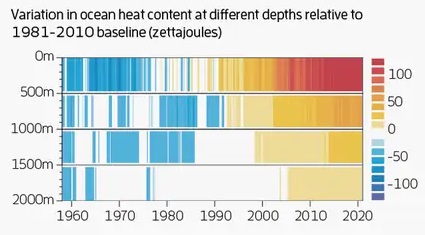
That heat in the upper layer will stay there with 1.5°C and zero emissions by 2050. Only a substantial drawdown to about 300ppm or more will allow its dispersion over a longish period of time.
Newberry, Huntley and others stress we need to be honest. With the science of the Swiss pair Desing and Widmer and others who are calling for real emergency action within the frame of the next decade, we can offer hope to the young and to the adults and old whose concern for a safe planet for their children and grandchildren must be paramount.
Labor has said it will follow the science on climate change, and I have no doubt it would. The question is, which science, the science of the Swiss pair, the science of James Hansen and company, the science continually being cited by Spratt and Dunlop, or the science of the IPCC?
As it happens the IPCC is due to report again with its sixth major Assessment Report in late July or August. No doubt there will be plenty of urgency, but I doubt there will be a radical change. Desing and Widmer’s article and new information about Thwaites Glacier are probably too late for inclusion.
Labor has also chosen to characterise climate change primarily as an economic opportunity. I would suggest three approaches in the upcoming election.
First, Labor must embrace the urgency of climate change action, and make it a leading point of difference with the Coalition.
Second, Labor should, beyond the economic opportunities, frame climate change as an intergenerational issue. We must act to provide a safe planet, which does not need to be a hair shirt existence. Energy will be plentiful. New technology shows we can produce food in smaller areas. There is scope for caring for nature, for rewilding threatened species and a richer life for all, not just avoiding the worst of the worst.
Labor should be frank about the future of coal and gas, with positive plans to transition to a new economy.
Third, Labor does not need to represent the current situation as an impending catastrophe. However, in joining mainstream science and international political action it should on gaining power instigate a comprehensive review of the climate situation, with broad scientific, economic and community input.
Finally, I would draw attention to a collection of Climate Change Videos: [showing] Indigenous, Health And Poverty, Human Rights, Glaciers, Rising Sea Levels, Refugees, Vulnerable Cities and a story just out ‘War’ footing needed to correct economists’ miscalculations on climate change, says professor.
In that last one:
-
Mainstream economists “deliberately and completely” ignored scientific data and instead “made up their own numbers” to suit their market models, Steve Keen, a fellow at University College London’s Institute for Strategy, Resilience and Security, told CNBC on Friday.
Now, a “war-level footing” is required to have any hope of repairing the damage, he said.
It goes right back to the 1975 Limits to Growth report which was essentially on the money, but was rubbished by mainstream economists.


This was a short one that turned out to be long.
Gotta go now. Tonight I’ll go through and put in some headings. I think there is also another link showing Chinese are financing 70% of new coal fired power stations in the world.
Funny thing is that going on to a war footing usually boosts an economy because not losing the war is so important that some of the normal rules that slow economies are ignored.
Tell me why going on a war footing to save the planet from an environmental disaster won’t boost the economy?
For one thing all the LNP subsidies for fossil energy wont be needed.
Well tighter is this month’s reading “plan”.
BUT
Look what you’ve done by putting this up …….
https://youtu.be/UHdnCnvYJeo
That started just up the road from where I am.
Never underestimate the Dutch
From Renew economy: “Shell, Exxon and Chevron stunned by courts and shareholders in climate blitz” https://reneweconomy.com.au/shell-exxon-and-chevron-stunned-by-courts-and-shareholders-in-climate-blitz/
Three of the world’s biggest oil and gas companies have suffered significant blows in quick succession, with a collection of court rulings and shareholder votes sending shockwaves through an industry rattled by accelerating climate action and the impacts of the COVID19 pandemic.
Overnight, a Dutch court found that Shell is required to reduce its total emissions, including those from operation but also those from the use of the products it sells (“scope 3” emissions) by 45% of 2019 levels by the year 2030, to align with global climate goals.
This was found on the grounds that climate impacts would breach the human rights of residents of the Netherlands, and the Wadden region. The case was brought in April 2019 by seven climate activist groups and led by Dutch environmental group Milieudefensie, and the findings were announced on Wednesday night, Europe time.
The court’s ruling found that Shell is directly culpable for the climate impacts created by the normal usage of the products it sells, namely oil and gas. It rejected the company’s arguments that not selling these products would result in others selling the same, or that the responsibility lies with consumers rather than fossil fuel companies.
The ruling sets the 45% emissions reductions target, and highlights that “[Shell] is free to decide not to make new investments in explorations and fossil fuels, and to change the energy package offered by the Shell group, such as the reduction pathways require…through the energy package offered by the Shell group, [Royal Dutch Shell] controls and influences the Scope 3 emissions of the end-users of the products produced and sold by the Shell group”.
Today, Australia’s Federal Court is set to rule on a similar case, asserting that the harm caused by coal extracted from a planned mine expansion in Whitehaven, NSW, is a breach of the rights of young Australians. “If the Court agrees that the Minister’s duty of care to protect young people from the harms of burning coal prevents her from approving the Vickery Extension Project there could be huge flow on effects for the approval of new, harmful fossil fuel projects in Australia”, write the group that brought the case forward.
Interesting to see how the Whitehaven goes.
COURT IS BEING ASKED TO DEFENT YOUNG PEOPLE’S INTEREST IN THE FUTURE!!!
Thanks, bilb and John.
When I turned off the computer today after posting the first news bulletin I heard Climate change activists win against Exxon Mobil and Chevron, Shell loses Dutch court case
and
Australian court finds government has duty to protect young people from climate crisis.
The court didn’t actually stop the Whitehaven mine extension for ‘technical’ reasons, but the precedent has been set and a door has been opened. The Federal minister must take into account the harm done to children in the future by burning the coal that is being mined.
I was interested in the fact that the mine is in NSW and the children were in Melbourne, and the coal may be burnt in a another country.
Brian: “I was interested in the fact that the mine is in NSW and the children were in Melbourne, and the coal may be burnt in a another country.”
Yep: The kids are affected equally by the CO2 emissions over the long term no matter where the coal is burned. However, there are also potential short term, local effects due to coals sulphur and other toxin content.
This turn around is such good news. It opens up the possibility, even the need, for companies like shel to find ways to be come the new energy pipelines of the future using their unique technologies in other ways. So what is the obvious local Australian opportunity for shell? Well Twiggy Forest’s submerged electricity HVDC cable to Asia would be my first pick. The cable and the massive amount of panel area to feed it. Then of course there is the need for hydrogen too, and even the water and CO2 to Methanol production.
It’s a big wide wonderful world of opportunities for a company with a pocket full of cash as Royal Dutch Shell is.
Perhaps the timing is perfect. Tell Twiggy he can stay on my boat for a few nights if he needs to.
bilb, one of my younger son’s friends works for Shell here in Brisbane. I think she’s a mathematician.
Shell has taken over one of the big Qld coal seam gas operations. She was monitoring fugitive emissions. They don’t have to here in Oz, because our emissions are theoretical, based on American stats, which are questionable. Shell anticipates that they will have to measure and be accountable in the future, so they were getting their methodology, baselines and history into order.
She did say the company was moving into electricity and renewables. So:
Shell is building its first solar farm at Wandoan in Qld, near where I grew up.
Here’s Shell’s latest news releases from our Renewables and Energy Solutions business as well as other low-carbon and renewable projects Shell is involved in around the world.
Here’s their schtick on Renewables and energy solutions
Also Shell hunts for hydrogen opportunities in Australia in net zero push.
So I was actually a bit surprised when the judge seemed to say they were a bit slack and even perfidious. Good to see the Dutch legal system is on their case.
Bilb: ” and even the water and CO2 to Methanol production.”
I have been also talking about ammonia as a transport fuel. Has the advantage over methanol of not needing to recover CO2 from the air. Pressure is similar to LPG.
Seem to recall twiggy talking about ammonia as a transport fuel.
So,technological answers are at the forefront of thinking,great!!

Indonesia bans new coal plants and pivots to renewables and carbon markets: https://reneweconomy.com.au/indonesia-bans-new-coal-plants-and-pivots-to-renewables-and-carbon-markets/
Indonesia is shifting towards greater levels of climate action as the country officially announces the government will not approve any new coal plants beyond those already under construction or at the stage of financial close, reported the Straits Times.
Energy and Mineral Resources Ministry director-general Rida Mulyana told a parliamentary hearing on Thursday that the country will offer renewable energy incentives, create carbon pricing mechanisms and introduce a carbon trading system.
“Southeast Asia’s largest economy will gradually shift about 5,200 diesel-powered plants with total capacity of 2 gigawatts to be powered by renewable sources”, reported Bloomberg, though it remains unclear what those renewable sources would be.
Thanks, John. Things are definitely on the move.
Three relevant links.
First Fred Pearce – Net-Zero Emissions: Winning Strategy Or Destined For Failure?
Net-zero emissions — balancing emissions by absorbing equivalent amounts of CO2 from the atmosphere — is the defining approach of international climate efforts. But some scientists are arguing that this strategy simply allows the perpetuation of the status quo and is certain to fail.
He’s mainly writing about an article by UK climate scientists James Dyke, Robert Watson and Wolfgang Knorr’s article Climate scientists: concept of net zero is a dangerous trap. They reckon the ‘net’ of net zero is a veil designed to hide business as usual.
Bob Watson was head of the IPCC at the turn of the century. Came from NASA. George Dubya Bush blocked his re-appointment when his term was up.
They are quite cynical about what has been going on, the role of scientists and the role of climate models.
They reckon scientists always knew the 1.5°C was impossible.
Pearce also links to Johan Rockström and Gail Whiteman,s commentary on Shell in Shell’s net zero plan will be judged on science, not spin.
Shell was increasing gas to 2030 and still exploring for oil, playing both sides of the fence. As were other companies.
Brian: “Net-zero emissions — balancing emissions by absorbing equivalent amounts of CO2 from the atmosphere — is the defining approach of international climate efforts. But some scientists are arguing that this strategy simply allows the perpetuation of the status quo and is certain to fail.”
Yep, the scope is limited. Tree planting and similar can hold CO2 until the tree dies and rots and land is also needed to grow food.
Finding porous rock to pump CO2 into is also a bit challenging and it has to be rock that won’t allow injected gas to get back to the surface.
Seems reasonable to say that stopping extracting fossil carbon is the most effective approach.
Seems reasonable that those advocating that approach would immediately abstain from consuming fossil carbon and derivatives of such.
Who among us is doing so ?
None I’m guessing.
Seems reasonable that those advocating libertarianism would be living the good life in some Galt’s Gulch somewhere, free from the unreasonable restrictions on their freedom imposed by the government.
Who among them is doing so?
None I’m guessing.
Jumpy you keep throwing out that dishonest argument. You know full well that the corrupt Liberal politicians crippled the ability of people being able to use their household solar power for their own purposes turning the national distributed energy system into a free money grab for the arrogant power industry.
The public desire to be as sustainable and environmentally responsible as possible is well entrenched in the community but the Howard philosophy of backroom deals concealed with bogus “commercial in confidence” claims.
As for driving electric vehicles Liberals killed our local ability to develop an Australian solution to sustainably fueled transport and with m ore backroom deals have ensured that any electric vehicles arriving in Australia are as unaffordable and un appealing as possible.
As for the energy to power the handful of electric vehicles that dop arrive in Australia “clean” viability is routinely demolished wit the disingenuous argument of “weel what source does the power come from?”
You’re full of Dung, Jumpy.
Interesting read: Has Australia’s gas-fired recovery run out of steam before it even began? Despite the title quite a bit of it is about courts and shareholders putting pressure on fossil fuel companies. https://www.abc.net.au/news/2021-05-31/has-the-gas-fired-recovery-run-out-of-steam/100177438
Interesting, John D, that the writer of that piece had the same reaction I had on the complete hypocracy of Liberals after the 2016 SA storm that brought down high tension lines and caused the shut down of much of SA’s renewable power system and the howl of protest against wind power in the wake of that, to now nothing at the failure of the coal plant itself causing consumer chaos.
John, Ian Verrender calls it as it is, I find.
I happened to buy the Oz today, and there on page 3 was a report saying that the workers on Snowy 2.0 were losing faith in the safety of the workplace. They were on FIFO working for a labour hire company, NX Blue.
Snowy 2.0 said safety of workers was their highest concern, but you really need to talk to their employer NX Blue.
NX Blue said safety was of course their highest concern, but they were bound by what their client says. Their client was Future Generation, a joint venture between Italy’s Webuild (formerly Salini Impregilo), Australian-based Clough and US-based Lane Construction working for Snowy Hydro.
The Oz had gained access to a report commissioned by the jv on safety by yet another company, which found that 42% of workers were negative or neutral about whether management was concerned about safety. Apparently the average project benchmark is 17.3%.
So the Oz reporter toddled off to the NSW AWU secretary to find out what was really going on.
He was advised that the safety standards were atrocious, and it was a matter of time before someone was killed.
He also advised that the workers were all casual, and being paid $30 per hour.
I blame John Howard for the gig economy, but someone has to fix this up. I know it won’t be the present mob.
bilb, when you say “causing consumer chaos”, there wasn’t a lot of complaining or hysteria around here. Blackouts are common enough from storms, but not usually in May.
Checking NEMWatch, Qld is mostly producing more than it consumes, but less and more gas, while NSW is producing less than it consumes, as usual. I doubt prices will be affected much, but we’ll see. We were assured by the Qld authorities that they won’t be, and it’s above my pay grade to differ.
I wasn’t there, Brian, so I …. may have been ..exaggerating.
But there is no amount of exaggeration can outperform the utter incompetence of Liberal Prime Ministers.
Abbott nixxed the car industry for purely egotistical reasons.
Morrison sucked up to Trump to big name himself, then was obliged to carry water for Trump’s phony Trade and Covid war with China.
China was offended.
So what happens next …..
https://apple.news/Aq8nvoOWFRwOa5rDHFrEYKQ
….. and when that happens it would be good to have some large industry that could be ramped up, like say, a car industry to make electric vehicles.
Sadly sociopath No. 1 destroyed the means of recovery for the damage to be created by Sociopath No2.
And that is no exaggeration.
Jumpy may have to retrain to become a solar panel cleaner.
The Ian Verrender article is a shocker.
bilb, I agree with all that. Government incompetence is now being highlighted in the COVID 19 outbreak in Victoria, where they say that vaccination is “not a race” and suddenly they are racing to get aged care residents and workers vaccinated, which was supposed to have been completed in the first round of vaccinations. They have also quietly allowed aged care workers to resume working at multiple sites.
Yesterday I heard a brilliant interview (worth 53 mins of time) with Richard Fidler and Jason Yat-sen Li on The five personalities of China.
It’s the best I’ve heard. Jason grew up in Australia with Chinese immigrant parents, became a lawyer, and has worked on international law in The Hague, was prominent in the move to make Australia a republic, and lived in China from 2005 to 2013 with his Caucasian wife and a couple of kids.
It’s a combo of personal experience and big picture awareness using simple language.
He has a solution for the present impasse, but he knows Morrison won’t take it.
Brian: “He was advised that the safety standards were atrocious, and it was a matter of time before someone was killed.
He also advised that the workers were all casual, and being paid $30 per hour.”
By contrast most of my work for contractors was with Thiess. All I can say is that Thiess had an impressive safety program that produced impressive safety performance. (Thiess was getting better results than BHP and BHP was pretty good with strong safety programs. Thiess also had a good working arrangement with the workers and paid properly on time.
Doesn’t mean that there were some real cowboys out there both in terms of safety and pay.
Sounds like Snowy 2.0 might be tolerating cowboys to save costs. If true it is ironic that an organization with many gas industry directors was tolerating this poor performance. By necessity the gas industry is usually incredibly strong on safety.
BilB
Nah, there’s so much work up here that I’m knocking jobs back left and right. The trouble seems to be lack of young people willing to bend their backs.
Talking to a block layer a week or so ago that estimates the average age of his kind was about 50 years old. And zero females to boot.
Nothing to do with politicians that aren’t your favourites.
Jumpy: “The trouble seems to be lack of young people willing to bend their backs.
Talking to a block layer a week or so ago that estimates the average age of his kind was about 50 years old. And zero females to boot.”
Some dumb questions:
What other jobs can the sort of young people your industry employs find in Mackay or elsewhere?
Are there a lot of back injuries from all this “back bending”?
Is the equipment available that would reduce the need for “back bending”?
Are award wages paid and are people payed on time?
How does your industry wages and conditions compare with the coal and heavy construction industries?
Is the demand for your type of worker boom and bust?
How many of the people employed by your industry get some of their income from the welfare system? Do they have problems with the complicated rules?
Are women who work in the industry more reliable?
What is the unemployment rate in your area? How many of these would you consider employing?
John, can you just choose one dumb question at a time please, I’m not a glorified typist.
If you choose just one dumb question at a time to answer, maybe the typing won’t overwhelm your skills.
Jumpy: Happy to see each answer as a separate comment.
I am genuinely curious to know why your industry is struggling to get enough employees who are suitable for the work.
My construction connection was all large scale stuff and the subbies I worked with were good at their job.
Also noted that the best project managers and subbies had teams that followed them around from job to job.
The fierce urgency of today.
Chapter 2. Politics
https://youtu.be/w-a158DU1mE
Great link, bilb. I did have to rescue it from the spam bucket.
This story came in a feed last night:
Crushing climate impacts to hit sooner than feared: draft UN report:
Climate change will fundamentally reshape life on Earth in the coming decades, even if humans can tame planet-warming greenhouse gas emissions, according to a landmark draft report from the UN’s climate science advisors obtained by AFP.
Species extinction, more widespread disease, unliveable heat, ecosystem collapse, cities menaced by rising seas—these and other devastating climate impacts are accelerating and bound to become painfully obvious before a child born today turns 30.
The choices societies make now will determine whether our species thrives or simply survives as the 21st century unfolds, the Intergovernmental Panel on Climate Change (IPCC) says in a draft report seen exclusively by AFP.
But dangerous thresholds are closer than once thought, and dire consequences stemming from decades of unbridled carbon pollution are unavoidable in the short term.
“The worst is yet to come, affecting our children’s and grandchildren’s lives much more than our own,” the report says.
By far the most comprehensive catalogue ever assembled of how climate change is upending our world, the report reads like a 4,000-page indictment of humanity’s stewardship of the planet.
I’ve seen the story about four times now via different organs. It should be the moment when the world wakes up and takes the threatening catastrophe seriously, but I’m not holding my breath.
The report they are referring to is the second of the AR6 Climate Change series – AR6 Climate Change 2022: Impacts, Adaptation and Vulnerability due in Feb 2022.
I think we’ll have an election before then so that spin can prevail before we deal with inconvenient truth.